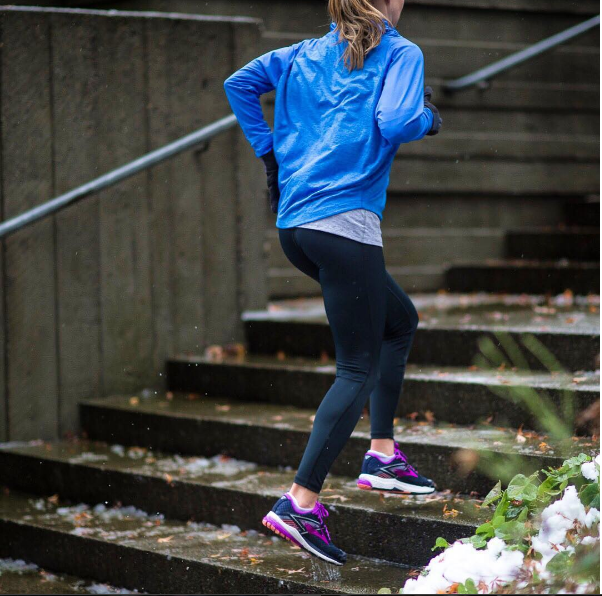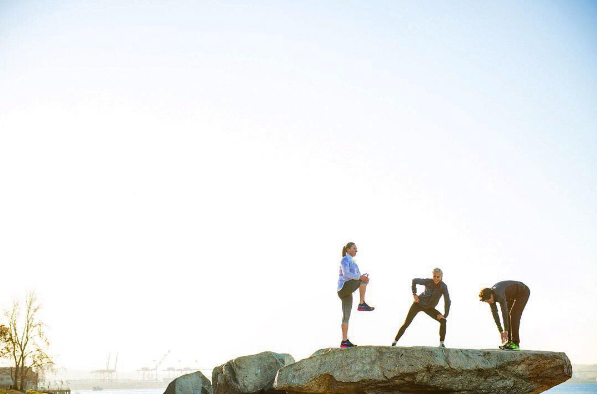Transition Weather Running Tips from Brooks
/Raise your hand if you're tired of Seattle's long, slow transition out of winter! There are lots of reasons to be sick of the cold and gray, but a big one is that it really limits the desire to work out outside. I asked Brooks Running's apparel expert and Global Apparel Merchandising Manager Sara Najjar for some of her thoughts and tips on working out in transition weather - how to dress and motivate yourself to get out the door, when to replace your gear, etc. Take it away, Sara!
Me after a run in happier (sunnier) times
How do you beat the morning snooze & get up for a run?
Even though I claim I’m not a morning person I have my best days when I work out or run in the morning. I know myself and if I try to plan something later in the day it will never happen. My other trick is to pick out my favorite outfit to wear for morning workouts. When you are comfortable and love what you are wearing it makes it much easier to get out the door. I always feel more productive knowing I had a good start to the day.
How do you psyche yourself up for a run in the rain?
Living in Seattle it’s hard to schedule yourself to avoid the rain. If it’s cold and raining I’ll opt for an indoor workout but if it’s warm outside the rain can be really nice. When I know it’s going to rain I try to pick items to wear that will keep me dry and comfortable. Even just adding a hat can make a big difference in the rain.
What are your top tips for running in transition weather?
My top tips for running in transitional weather is to know yourself and always be prepared. If you run cold it’s best to layer so it’s easier to add or remove layers as your temperature changes. Also, don’t forget the power of accessories. A hat, lightweight gloves or arm warmers can keep you warm and are easy to pack away in a pocket when you no longer need them. If you run warm, like me, then it’s more about protecting yourself from the elements. I try to be prepared for changes like rain and wind. Our LSD jacket is a favorite go-to piece. It’s super lightweight and packable so it doesn’t take up much room. I’m always happy I have it when the weather changes.
How should one dress for running in transition weather?
Transition weather can vary greatly from one area of the world to the next. In Seattle, where our transition temperatures vary between 50 – 30 degrees, it’s really important to layer. It’s incredibly common in Seattle to start your run in the sun and end in a downpour or vice versa. For your top, I would recommend a short or long sleeve shirt like Streaker Short Sleeve and Long Sleeve which are seamless and constructed with our DriLayer Burst® fabric to minimize odor. I would suggest pairing these with a mid-weight pant like our Greenlight Tight and Capri. If you run a little colder, you should consider throwing on a jacket. The Cascadia Jacket is perfect for the rain because it offers waterproof and windproof protection, while the LSD Jacket is an incredibly lightweight windproof and water-resistant option that can easily be packed away in its own pocket when you warm up.
How do you avoid over/under layering?
The best way to avoid over/under layering is to layer! Everybody’s body temperature is different so it’s really important to learn what works best for you. Wearing layers will make it easy to cool down or warm up depending on how you feel.
While everyone’s body temperature is a little different, the following is a general guidance on how to dress for varying temperatures:
- Temperatures in the 50’s: Long sleeve or short sleeve shirt and capri/tights.
- Temperatures in the 40’s: Long sleeve shirt and capri/tights. If you generally run a little colder, you may want to throw on gloves and a headband.
- Temperatures in the 30’s: Log sleeve shirt and capri/tights, gloves and a headband to cover ears. If you run a little colder, a vest or lightweight jacket could come in handy.
- Temperatures in the 20’s: Two shirts layered (long sleeve shirt and short sleeve shirt or long sleeve shirt and jacket), tights, gloves and headband or hat.
- 20 Degrees and Below: Two shirts layered, tights, gloves or mittens, headband or hat as well as a thermal/insulated jacket that will block the wind.
What gear should we replace and when?
We believe that even the best gear should be replaced at some point to provide the best experience for the runner. My colleagues on our Brooks footwear team recommend that running shoes be replaced every 300-400 miles. If you don’t track your miles, other telling signs that your shoes need an update include broken down cushioning, worn out tread on the bottom of your shoes as well as aches and pains that can’t be attributed to your training.
For sports bras, we recommend that your bra should never celebrate a birthday—you should replace every 6-12 months. Pay attention to key signs such as stretched bottom band and straps, faded tags, possible chafing spots, and a less-than-fresh scent.
A well-cared for apparel garment should still be running strong after 50 home launderings. Signs that you need to go shopping are very similar to sports bras.
Do you have any favorite running routes in the city?
Anywhere near the water especially when it’s a beautiful day! The Green Lake loop is always a great go to as well as the Burke-Gilman trail which is just a block from our office.
Thanks, Sara & Brooks!
















